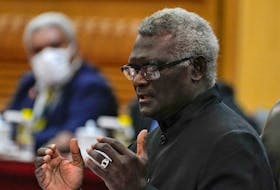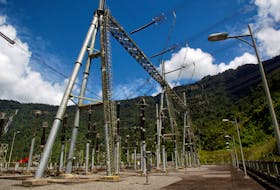ST. ANTHONY, N.L.- The province’s decision to award Active Energy Group (AEG) two five-year forestry permits on the Great Northern Peninsula is coming under scrutiny.
Questions surround the company’s ability to deliver.
AEG’s subsidiary, Timberlands Newfoundland, has been authorized to cut 100,000 cubic metres in forestry districts 17 and 18 on the Great Northern Peninsula.
This will allow the company to produce wood pellets to ship to markets in Poland.
A $19.7 million pellet plant has been slated for construction in the town of Hawke’s Bay.
However, not everyone is in favour of the deal.
Leander Pilgrim, a former forestry operator on the Great Northern Peninsula and former mayor of the town of Main Brook, has been opposed to AEG’s proposed operation since it was first discussed in the media in 2017.
His concerns at the time focused on the environmental impact forest clear-cutting may have on the Great Northern Peninsula.
This issue remains a major priority for Pilgrim. He is now questioning why the provincial government did not require Active Energy to submit an environmental preview report.
But additional research into Active Energy also has him questioning the company’s ability to carry out its plans for the Great Northern Peninsula and whether the provincial government did its due diligence in researching the company before issuing the permits.
He addressed these concerns in a December letter sent to provincial government officials – including Premier Dwight Ball, Fisheries and Land Resources Minister Gerry Byrne and St. Barbe – L’Anse aux Meadows MHA Christopher Mitchelmore, among others – and later to the official opposition.
Pilgrim waited a few weeks for a reply, hoping someone would heed his concerns.
But there was no response.
“Not a sound from nobody,” he told The Northern Pen.
He decided to turn to the media to get his message out there.
AEG’s financial situation
In his letter, Pilgrim draws attention to AEG’s financial standing as a cause for concern.

He points out that according to a Sept. 28, 2018 audit, the company did not generate any revenue after its wood fibre operations closed in Ukraine, between December 2017 and June 2018.
The company’s retained earnings show losses of $37,247,881 (USD) and its total equity is listed as minus-$254,270 (USD).
AEG’s own report on Sept. 28 indicated uncertainty about its future.
It stated that directors were in the process of securing various sources of funds, with the belief the group would have sufficient cash resources to trade for a period of at least 12 months from that date.
However, it points out that “as of the date of signing these financial statements, none of the potential sources of funds have been finalised and therefore there can be no guarantee that further funds will be received. These circumstances indicate the existence of a material uncertainty which may cast significant doubt on the Company's ability to continue as a going concern.”It stated that directors were in the process of securing various sources of funds, with the belief the group would have sufficient cash resources to trade for a period of at least 12 months from that date.
In other words, the company’s future is in question.
Pilgrim said he felt, “This statement alone… should have brought this project to a grinding halt.”
Minister Byrne told The Northern Pen during a phone interview last week that this matter had been noted by the province.
He says there were no “red flags” when the province investigated the company’s financial standing and ability to raise capital.
But the government has mitigated risks in a few ways.
According to Byrne, the company’s financial standing factored into the department’s decision to offer five-year permits to AEG instead of the 20-year permits first sought by the company.
Conditions in the permits also require that by the first 30 months, 40 per cent of timber must be harvested and the company must show they have the capacity.
“If it fails to do so, it will lose those privileges,” he said. “That’s the protection that’s afforded to the people of Newfoundland and Labrador and to the public resources which we all own.”
Lastly, he notes that the provincial government will not be providing the company any financial support.
Spinks and company background
Pilgrim also raises concerns about Richard Spinks, the managing director of Timberlands Newfoundland (AEG subsidiary), and his ability to handle a project of this kind.
He points to Spinks’ agricultural business in Ukraine, from 2008-09, as CEO of LandKom PLC.
According to a 2010 article from Business New Europe Intellinews, the business suffered pre-tax losses of $53.3 million in 2008 and of $27.2 million for the first 10 months of 2009.
The company was unable to secure reimbursement from the Ukrainian government before Spinks resigned that same year.
LandKom blamed the country’s political and financial uncertainties for its inability to secure reimbursement.
But Pilgrim highlights how the then new CEO Vitaly Skotsyk, placed blame on the company’s previous management.
“You need local knowledge to operate in Ukraine,” Skotsyk is quoted as saying. “Most problems faced by LandKom have been caused by the fact that it is the only 100 per cent foreign-owned company in Ukrainian agriculture and also had 100 per cent foreign management.”
Pilgrim felt the same could be said for the Great Northern Peninsula.
“AEG, is a foreign-owned company, whose majority shareholders are venture capitalists, hedge fund managers and private equity firms, who care little for and know nothing of our forests,” he wrote.
In response to this assertion, Minister Byrne points out that the company is enlisting local forestry contractors to do the wood cutting.
Pilgrim says more trouble came for Spinks, when he was CEO of AEG, in northern Alberta.
Per the Edmonton Journal, in 2015, a northern Alberta timber deal AEG had made with three Metis settlements was put on hold.
The three Metis groups were found to have violated the province’s Metis Settlements Act by entering into a joint venture agreement with Active Energy without due diligence.
The report says the “investigation found the settlements” councils “provided insufficient evidence” that proper planning, risk assessments and consultations were done before the joint venture agreement was signed.
Pilgrim questions why the provincial government did not conduct the same research into Spinks and AEG. Or, if they did, why the research was disregarded in the decision to award the company permits.
Government response
However, Byrne says the government has looked into the company, but feels it is not in a position to analyze and investigate every business transaction AEG or Spinks has done.
He says he does not want to hold businesses, both local and foreign, to the standard that Pilgrim is suggesting.

For instance, he says there are many pre-existing companies on the Great Northern Peninsula who have faced financial difficulties in the past as well.
“I would not want to hold everyone and anyone to a standard that if you have met with some measure of distress in the past, you are no longer eligible to be considered to operate in the future,” said Byrne. “That would put quite a hold on many businesses that currently exist on the Great Northern Peninsula.”
He adds that AEG is a company that trades on a fellow commonwealth country’s stock exchange (the London Stock Exchange) and has operated since 1997.
Byrne says the government has also confirmed with the stock exchange that AEG has been in full compliance with its regulatory requirements since it was first listed.
The minister trusts the judgment of the securities regulatory.
Byrne stresses that he’s not saying he is absolutely certain this project will succeed.
“There is risk to this project and it may not succeed, I don’t know,” he said. “I’ve been given reasonable assurances based on our analysis and due diligence that it has a good, strong opportunity to succeed.”
The Northern Pen contacted Richard Spinks by email but did not receive a response prior to deadline.
Environmental preview report questions
If Active Energy Group (AEG) is able to deliver, former forestry operator Leander Pilgrim still has concerns about the project’s environmental impact.
He is critical of the Department of Fisheries and Land Resources’ decision to issue the permits without AEG submitting an environmental preview report (EPR) first.
He writes there are five sections in Part III of the province’s Environmental Assessment Regulations Act, indicating the proponent should have registered for an environmental assessment. They are sections 28, 36, 39, 41 and 47.
The regulations act can be read online at: https://www.assembly.nl.ca/Legislation/sr/Regulations/rc030054.htm
By approving the project without an environmental registration from the company, Pilgrim feels the government has denied residents of the Great Northern Peninsula the “opportunity to express their support or rejection” while also denying scientists at the Department of Municipal Affairs and Environment the opportunity to perform “their own due diligence.”
It is noted in the letter that the Department of Fisheries and Land Resources did submit its own environmental registration to the Department of Municipal Affairs and Environment in 2017.
The submission is for a five-year operating plan for forest management districts 17 and 18.
The project description states that the “undertaking is necessary to maintain and/or expand the existing commercial industry and allow domestic harvest for home building and heating.”
It covers from Jan. 1, 2018 to Dec. 31, 2022 and is listed as Registration #1905 to the Department of Municipal Affairs and Environment.
The Municipal Affairs and Environment Minister of the day, Eddie Joyce, released the project on Jan. 2, 2018.
Pilgrim was critical of the plan, noting that it “authorizes clear cutting” and feeling it “only provides minimal protections for our waterways and natural beauty.”
He feels there’s nothing in the registration about how a company like AEG is actually going to operate once they’re in the forest.
Furthermore, he says there’s no documentation from AEG to indicate they actually understand the registration.
Pilgrim maintains that AEG should have been required to submit an EPR of their own.
Instead, he says the province has allowed AEG to “piggyback” on Environmental Registration #1905.
Since The Northern Pen received Pilgrim’s letter, the Department of Municipal Affairs and Environment has confirmed to the newspaper that it has required an environmental assessment from AEG for the pellet plant to be constructed in Hawke’s Bay.
The company has been notified.
Furthermore, Fisheries and Land Resources Minister Gerry Byrne contests Pilgrim’s assertion that AEG should have been made to submit an EPR report for the forestry component of their operations.
According to Byrne, this principle would then have to extend to every forestry operator on the Great Northern Peninsula.
“Leander would also then have to make the case that Coates’ Lumber (in Main Brook) or Gibbons’, all of the timber companies and harvesters on the Northern Peninsula, should also submit environmental assessments,” he said.
This is contrary to how the environmental assessment process works, says Byrne.
For each forestry district, the Department of Fisheries and Land Resources submits a five-year forestry operating plan that every operator must comply with.
The latest operating plan for districts 17 and 18 was Registration #1905.
This was open to public input from July to August 2017.
AEG, like every other forestry operator, had to be found in full compliance with the forestry regulations in the operating plan before permits were issued to the company.
“They do not get to invent or create or to assume any of their own practices, every one of their practices has to be in compliance with the existing rules,” said Byrne. “And that’s why there only needs to be one environmental assessment. They do not get to invent how they will harvest trees or fibre, because they must operate, and they will operate, under the forestry regulations.”
Meanwhile, Pilgrim is concerned it would take 80 years for the forest to recover.
“It’s a waiting period of 80 years for trees to grow back to log size (per Registration #1905),” he told The Northern Pen during a phone interview. “That speaks for itself as a real disaster for our people.”
But Byrne feels AEG is operating under tighter regulations than Pilgrim, himself, did when he was a forestry operator.
“He did not operate under a certified forest practice regime, which AEG will have to,” said Byrne.
The minister felt the implication in Pilgrim’s letter is that the status quo on the Great Northern Peninsula is fine.
“If you were to publish his letter in full, people would judge for themselves that what he’s saying is, ‘We got it made up here’,” he said.
“I don’t believe that. I don’t just believe that as a minister and I don’t believe that as a former resident of the town of Main Brook and someone with a deep personal connection to the Great Northern Peninsula.”
RELATED








